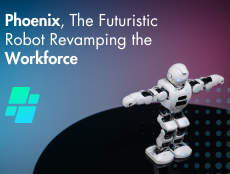AI creativity is at its peak..!!
The remarkable emergence of Artificial Intelligence has been a catalyst for innovation across various sectors.
Read more: Google’s Biggest AI Search Update
Considering the widespread adoption of OpenAI’s ChatGPT as a conversational agent, it is interesting to imagine the possibilities if such a chatbot were embodied as a physical robot capable of providing real-world support in various tasks.
It appears that the advent of AI-driven robotics is approaching.
And one such latest technology marvel has stepped into the market.
It’s called “Phoenix”, introduced by Sanctuary AI.
It’s a humanoid robot that leverages the power of artificial intelligence to seamlessly integrate into various industries.
As per the company’s statement, their robots are equipped with human-like intelligence, which is a groundbreaking achievement in general-purpose robotics. This development appears to be a significant advancement in the field of artificial intelligence, which the prevalence of chatbot technology has largely characterized.

Phoenix Characteristics
- Form and functionality similar to that of a human, measuring 5 feet and 7 inches tall or 170 cm and weighing 155 pounds or 70kg.
- 3 mp/h or 5 km/h is the highest possible speed.
- There is a limit of 55 pounds for the maximum payload.
- Industry-leading robotic hands with expanded degrees of freedom (20 in total) rival human hand dexterity and delicate manipulation with unique haptic technology that simulates the feeling of touch. These hands are capable of performing complex tasks.
- A more vibrant color scheme and richer textures have provided a more aesthetically pleasing appearance.
Carbon: The Brain Behind Phoenix
The cognitive architecture known as Carbon is what drives Phoenix forward. Phoenix is able to carry out activities in the same manner as a person because it incorporates contemporary AI technologies, which transform spoken language into actions. The system utilizes deep learning and reinforcement learning to ensure the highest possible level of performance. Carbon is packed with the following characteristics:
- It is a Building block for intelligence in humanoid, multipurpose robots.
- Leverages cutting-edge AI methodologies to facilitate the seamless translation of natural language inputs into measurable real-world outcomes.
- The technology facilitates Phoenix’s cognitive and behavioral capabilities to imitate human-like task completion.
- Has freedom of action and pursuit of a goal.
- Makes use of both deep learning and reinforcement learning.
- Logic, activity, and action plans are auditable and can be explained by combining symbolic and logical reasoning with contemporary LLMs (for general knowledge), domain-specific integrations, and extensions.
- Training robots with photo- and physics-realistic models of the real world.
- Control, fleet management, and teleoperation with a human in the loop.
The Unique Vision of Sanctuary AI
Sanctuary aims to leverage general-purpose robots to address labor market shortages through a “labor as a service” business model, wherein robots seamlessly integrate into the existing workforce. The customers are expected to remunerate the robots for their services at mutually agreed rates without incurring any initial capital expenditures or operational modifications.
According to Geordie Rose, the co-founder and CEO of Phoenix, “We designed Phoenix to be the most sensor-rich and physically capable humanoid ever built and to enable Carbon’s rapidly growing intelligence to perform the broadest set of work tasks possible.”
He further added, “We see a future where general-purpose robots are as ubiquitous as cars, helping people to do work that needs doing in cases where there simply aren’t enough people to do that work.”
The objective is to create an experience where users feel like they are onboarding a new employee. This involves implementing existing systems that are typically utilized for human resources but applying them to this novel technology.
Final Words
The introduction of Phoenix is a noteworthy achievement in the field of robotics, as it boasts a humanoid physique, unparalleled agility, and cutting-edge artificial intelligence.
With the increasing prevalence of general-purpose robots, we can expect a future characterized by enhanced work efficiency, alleviated labor shortages, and amplified prospects for individuals unable to undertake physical tasks.

